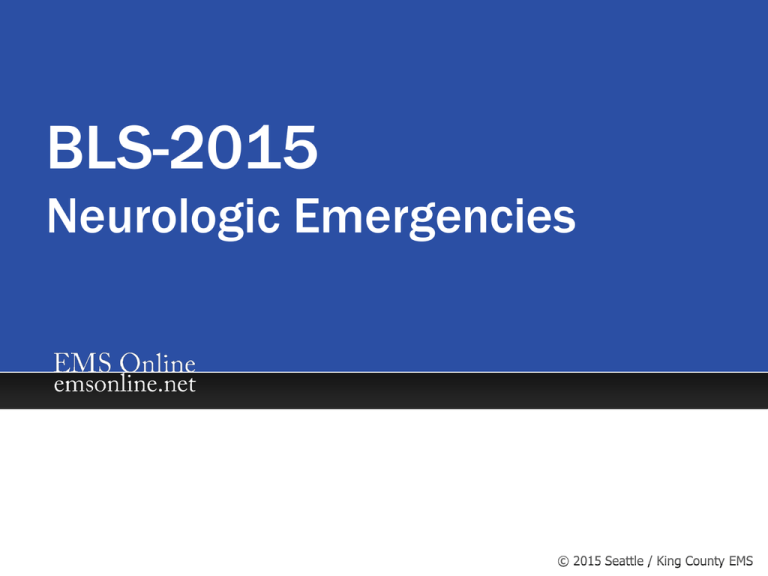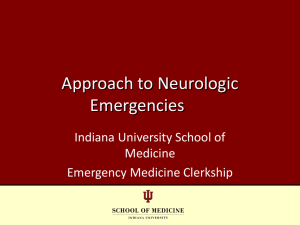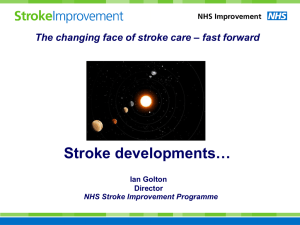
BLS-2015
Neurologic Emergencies
Introduction
There is a wide variety of
neurologic emergencies which we
encounter in the field.
Not all are treated or transported
in the same way.
You need to quickly and
accurately determine the
patient’s disease or condition so
you can make the right treatment
and transport decision.
The key for ischemic stroke
patients – clot-busting therapy
within 3 hours of the onset of
symptoms
Practical Skills
To receive CBT or OTEP credit, a trained evaluator must
evaluate your ability to perform the following practical skills:
Determine whether the patient is SICK or NOT SICK on initial
assessment
Conduct a patient history and physical exam
Recognize a variety of neurologic patients
Administer the FAST exam to the appropriate patient
Recognize symptoms of ischemic stroke and need for short scene
times
Provide emergency care for neurologic emergencies
Learning Objectives
Review neurological anatomy and physiology at the
Basic EMT Level
Recognize common neurologic emergencies
Distinguish between the two types of stroke
Recognize the underlying causes of stroke
Recognize the signs and symptoms of stroke
Determine the reasons why an ischemic stroke patient
must be assessed and transported quickly
Choose the correct BLS treatments for different
neurologic emergencies
Terms
atherosclerosis — a condition characterized by the deposit of fatty
plaques containing cholesterol and lipids on the innermost layer of the
walls of arteries
clot-busting therapy — dissolves blood clots in a procedure termed
thrombolysis; limits the damage caused by the blockage of the blood
vessel
dysarthria — difficulty in pronouncing words, caused by impairment in
the control of the muscles used in speech
embolism — a clot that travels from one part of the body to another until
it becomes lodged in an artery
expressive aphasia — aphasia in which the power to communicate by
writing, speaking, or using signs is diminished or lost. Also called motor
aphasia.
Terms
foramen magnum — the opening in the base of the skull through which
spinal cord passes to cranial cavity and becomes the medulla oblongata
hemiparesis — partial weakness affecting one side of the body
hemiplegia — complete paralysis on one side of the body
hemorrhagic stroke — a type of stroke that occurs when a blood vessel
bursts inside the brain
hyperlipidemia — elevated lipid (fat) levels in the blood
Terms
infarction — localized area of cell death due to a lack of oxygenated
blood
ischemia — deficiency of oxygenated blood in a body part as a result of
decreased blood flow
migraine headache — migraines are thought to involve abnormal
functioning of brain's blood vessels. Migraines may cause pain, visual
disturbances, and stomach upset; they may be preceded by an aura
receptive aphasia — inability to comprehend written or spoken words
Terms
seizure — uncontrolled electrical activity in the brain, which may produce
a physical convulsion or twitching of the body
status epilepticus — one continuous seizure lasting longer than 30
minutes or recurrent seizures without regaining consciousness between
seizures
stroke — occurs when blood flow to the brain is interrupted either by a
clogged or ruptured artery
thrombolysis — breakup of a blood clot, typically by medicine
Terms
thrombus — blood clot that typically forms over fatty plaque deposits on
the inner wall of arteries
transient ischemic attack (TIA) — temporary interruption of blood flow to
the brain with symptoms similar to that of an ischemic stroke but with
no permanent effects
Three Regions of Brain
Cerebrum
Cerebellum
Brain Stem
Graphic illustrations credit: LifeART(R) image, Copyright 1998,
Lippincott Williams & Wilkins. All rights reserved.
Cerebrum
Thought
Memory
Personality
Speech
Motor function
Vision
Tactile impulses
(touch)
Cerebellum
Regulates & coordinates
muscle activity & balance
Receives impulses from
eyes, ears, peripheral
joints, muscles
Brain Stem
Heart function
Respiration
Autonomic nervous system
Digestion
Glandular secretions
Connects brain to spinal cord
TAKE A TOUR OF THE BRAIN
Stroke Association
The Nervous System
The nervous system is comprised of billions of nerve
cells, called neurons. Neurons sense stimuli, relay
impulses, and send impulses to muscles to help the
body react to stimuli.
The nervous system is composed of the Central Nervous
System (CNS) and Peripheral Nervous System (PNS). The
CNS is comprised of the brain and the spinal cord. The
PNS is comprised of rest of the nerve cells throughout
the body. The PNS is literally “the eyes and ears” of the
central nervous system.
The Nervous System
The nervous system is composed of the Central Nervous
System (CNS) and Peripheral Nervous System (PNS).
CNS: brain & spinal cord
PNS: the rest of the nerve cells throughout the body
The peripheral nervous system is broken down into two
parts: a voluntary system and an involuntary system.
The Nervous System
Voluntary system – also called the Somatic Nervous
System, the voluntary portion of the PNS controls
muscular movement
Involuntary system – also called the Autonomic Nervous
System, the involuntary portion of the PNS controls
everything which we cannot consciously control
ourselves – heart rate, respiratory rate*, digestion, pupil
dilation, and many others
The Autonomic Nervous System is further broken down into the
Sympathetic and Parasympathetic Nervous Systems
Common Neurologic Emergencies
Stroke
Ischemic
Hemorrhagic
Types of Stroke
Ischemic: A blockage
caused by a clot. This is the
most common type of stroke.
Types of Stroke
Hemorrhagic: A rupture
caused by a break in a blood
vessel. Less common than
ischemic stroke but often has
higher mortality.
Ischemic Stroke
Thrombus
Clot that develops at site of blockage
Near area of plaque
Causes a sudden occlusion
Sudden onset of neurological deficits
Clot-busting drugs are time sensitive
Ischemic Stroke
Embolus
Clot floats to site to form a
blockage
Circulates in bloodstream until
it gets stuck in a smaller artery
Hemorrhagic Stroke
Ruptured blood vessel on
surface of the brain
(subarachnoid)
Ruptured blood vessel within
brain (intracerebral)
Puts pressure on the brain
Types of Stroke
Both types of stroke
Prevent oxygenated blood from reaching the brain tissues
May have only minutes to get patient to definitive treatment
Time lost is brain lost; seconds count.
Transient Ischemic Attack
A temporary interruption in blood supply to the
brain
Causes stroke-like symptoms that resolve
completely within 24 hours
Risk Factors
Hypertension
Smoking
Age
Gender
Heredity
Prior stroke
Diabetes
Carotid artery disease
Heart disease
TIAs
Signs and Symptoms
Paralysis or weakness on one side of the body
Facial droop on one side
Altered level of consciousness
Change in personality or mood
Headache or dizziness
Impaired speech
Blurred vision
Poor coordination
Aneurysms
A common cause of a ruptured artery in the
brain is an abnormality or weakness in the
vascular wall called an aneurysm
Altered Mental Status
Any number of medical emergencies or conditions
can cause an alteration in a patient’s mental status
trauma
disturbances in oxygen flow to the brain
electrolyte imbalances
presence of intoxicants or poisons, too much or too
little glucose in the blood
psychiatric disorders
serious infections
Seizures
A seizure can have many different
presentations. Most often, it is a convulsion
of the muscles of the body.
Tonic-Clonic
Partial
Febrile
Seizure Disorders
Seizures – electrical storm in the brain
Epilepsy
Tumor (benign of cancerous)
Infections such as meningitis, encephalitis or AIDS
Scar tissue from injury
Head trauma
Stroke
Hypoxia
Abnormal blood chemistry
Hypoglycemia
Poisoning
Use of illegal street drugs like cocaine or amphetamines
Drug overdose
Alcohol/medication withdrawal
Sudden high fever
Seizure Disorders
Status Epilepticus – life-threatening
Acute, prolonged epileptic crisis
Seizure can last longer than 5 minutes and/or many
seizures & does not wake up between seizures
Medical emergency – requires quick medical treatment
& ALS intervention
Complications include:
airway compromise
dysfunction of the heart or lungs
metabolic changes
increase in body temperature
irreversible brain injury
Headaches
Your History and Physical Exam, including
Vital Signs, will help clarify whether this a
nuisance or a medical emergency
Initial Assessment
SICK
or
NOT SICK?
Determine SICK or NOT SICK early in the call
Physical Exam
A SICK patient is one who can die quickly unless you
initiate aggressive BLS and ALS treatment and rapid
transport.
A NOT SICK patient is one who can be ill or injured, but
not severely enough to be life threatening right now.
ABC’s
Skin Signs
Work of breathing
The FEEL of the pt’s pulse – not the Pulse Ox. HR Reading!
Overall Appearance
Physical Exam
Key Clinical Indicators
Pulse
Respirations
Mental status
Skin signs and color
Overall Appearance
Relative to stroke
Baseline vital signs
FAST exam
Blood glucometry
SICK
or
NOT SICK?
FAST
Based on Cincinnati
Prehospital Stroke
Scale
F – Facial droop
A – Arm drift
S – Speech
T - Time
Accurate in identifying
patients with stroke
An abnormal finding
in ANY three tests
strongly suggests a
stroke
FAST
FAST
Test
Normal
Abnormal
Facial droop
Both sides of the face
move equally
One side of the face does not move as
well as the other
Arm drift
Both arms move the
same or both arms do
not move at all
One arm drifts down compared to the
other or one arm does not move
Speech
The patient says
correct words with no
slurring of words
The patient slurs words, says the wrong
words, or is unable to speak
Time
Establish the Time the patient was last known to b e normal
Video FAST Exam
Time of Onset
Determine time of onset – time patient was last
known to be normal
Keep scene times very short…goal is 15 minutes
Be aware of time it takes for the hospital staff to
assess and administer thrombolytic therapy
Clot-busting drugs are time sensitive
and must be given as early as possible
Patient History
Stroke patients often
report loss of motor
function and/or a
change in speech
pattern
Some experience
altered LOC
SAMPLE history to
determine if there is a
history of:
Hypertension
Blood thinners or
anticoagulants
Arteriovenous
malformation (AVM)
Cerebral aneurysm
Prior stroke
Patient History
Chief complaint and time of onset are key in the
assessment of stroke.
Care for Stroke
Protect airway
Ensure adequate respirations
Remove secretions that can be aspirated
Provide ventilation assistance
Proper positioning
Administer oxygen if saturation level is below 95% or
there are signs of hypoxia
Candidate for clot-busting therapy?
Initiate immediate & rapid transport to appropriate medical
facility
Short Scene Times
Victims of stroke often deny or rationalize their
symptoms
Patients eligible for clot-busting drugs must be
transported immediately
Notify hospital that possible stroke patient is en route
Avoid delays if patient waited before calling for help
When possible…keep scene time to 15 minutes
Latest Treatments
tPA FDA approved clot buster medication
May reduce long-term disability
Intra-atrial clot removal
Does not have time limit
Restores blood flow by removing blood clots
View the video
Revascularization of occluded vessels
Uses suction to grab blood clots
Effective if used within 8 hours of symptom onset
View the video
Seizures - Emergency Care
Basic Life Support care includes:
Once patient is awake,
perform examination to
determine if any injuries
occurred or if any neurologic
abnormalities exist
During seizure, position
patient on his/her side
Maintain the airway
Protect patient from injury
During and after seizure,
provide oxygen
Perform blood glucometry
Obtain oximetry reading after
seizure
Advanced Life Support indicators
include:
Multiple seizures (status
epilepticus)
Single seizure lasting longer
than 5 minutes or more than 15
minutes postictal with no
improvement in level of
consciousness
Seizure due to hypoglycemia
Seizure due to hypoxia
Seizure following head trauma
Drug or alcohol associated
seizure
Pregnant female
Headaches - Primary
Tension – most common type headache
Causes
Tight muscles in shoulders, neck, scalp, jaw
Related to stress, depression, anxiety
Headaches - Migraine
Pain – intense pulsing or throbbing in one area of head
Aura – visual disturbance
May see spots, dots, zigzag lines
Temporary loss of vision
Nausea, vomiting can occur
EMS gets called – perform thorough
exam and physical
Headaches - Secondary
Rare causes of headaches
Brain infection
Brain tumor
Stroke
TIA
Neurologic symptoms –
consider ALS
Weakness
Sensory
Altered LOC
“Worst headache of my life”
Patients with these type symptoms
Need hospital evaluation
Summary
Three regions of the brain are cerebrum, cerebellum and
brain stem
Two basic types of stroke are ischemic (blockage) and
hemorrhagic (rupture)
Ischemic stroke can be caused by a thrombus which is a
clot that forms in a cerebral artery or an embolus which
is a clot that travels to the brain
Summary
Signs and symptoms of stroke include:
Paralysis or weakness on one side of the body
Facial droop on one side
Altered level of consciousness (from confusion to
unconsciousness)
Change in personality or mood
Headache or dizziness
Impaired speech
Blurred vision
Poor coordination
Summary
Three tests of the FAST exam are facial droop, arm drift
and speech with T for Time
Determine last time patient was last known to be
normal. This helps determine if a patient meets the time
window for clot-busting therapy
Short scene and transport times are vital – try to keep
scene time to 15 minutes
Summary
Seizures can have many causes, including medicines,
high fevers, head injuries and certain diseases
Most common type of headache - tension headache
Migraine a very specific type of headache
Pain often described as intense pulsing or throbbing pain in
one area of the head
Any headache with neurologic symptoms – weakness,
sensory, altered LOC warrant consideration of ALS
Headache usually develops suddenly & without warning
Patient may say, “This is the worst headache of my life.”







